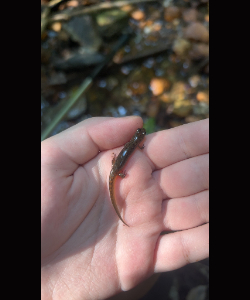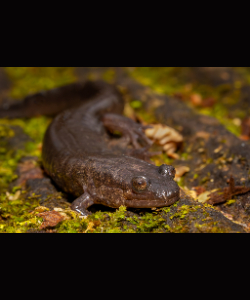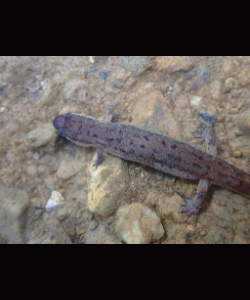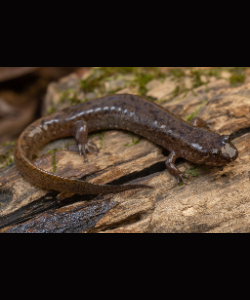Talladega Seal Salamander (Desmognathus cheaha)
Description: The seal salamander is a fairly robust species that ranges in color from tan to dark brown. The patterning of the back is highly variable and may range from well-defined light spots to a dark splotchy or net-like pattern. The belly is light and unmottled with little or no flecking. Larvae and juveniles tend to be more boldly patterned with well-defined pairs of spots down the back.
Habitat: The Talladega seal salamander occurs in streams throughout its range. Populations in the Coastal Plain appear to be restricted to high-gradient streams and microhabitats in contact with rock and flowing water.
Range: The Talladega seal salamander can be found in Georgia, Alabama, and Florida. This species occurs in the Ridge & Valley, Piedmont, and Coastal/Southeastern Plains physiographic provinces, in contrast with Desmognathus monticola, which predominantly occurs in the Appalachian highlands. The only known population in Florida is believed to have undergone a dramatic population decline, and may be extirpated, after nearby logging activities impacted stream habitat.
Found in these States:
AL |
GA
Diet: Seal salamanders primarily comsume small aquatic and terrestrial invertebrates. Larger individuals will consume larger prey items. Seal salamanders will occasionally consume smaller salamanders.
Reproduction: Females typically lay eggs in or around running water and guard them until hatching. Young seal salamanders overwinter as larvae and metamorph into adults during the spring. Larval seal salamanders have external gills are fully aquatic while metamorphosed individuals tend to occupy the stream margins and move between aquatic and terrestrial habitat.
Status: Listed as Least Concern in view of its wide distribution and presumed large population.
Taxonomy: October 2023, Taxonomic Split 132563 (Draft) Desmognathus monticola split into Desmognathus monticola and Desmognathus cheaha
»» Kingdom: Animalia - Animals
»» Phylum: Chordata - Chordates
»» Subphylum: Vertebrata - Vertebrates
»» Class: Amphibia - (Amphibians)
»» Order: Caudata - Salamanders
»» Family: Plethodontidae - Lungless Salamanders
»» Genus: Desmognathus
»» Species: Desmognathus cheaha - Talladega Seal Salamander
This article uses material from the Wikipedia article "Talladega Seal Salamander", which is released under the Creative Commons Attribution-Share-Alike License 3.0. Content may have been omitted from the original, but no content has been changed or extended.
|













